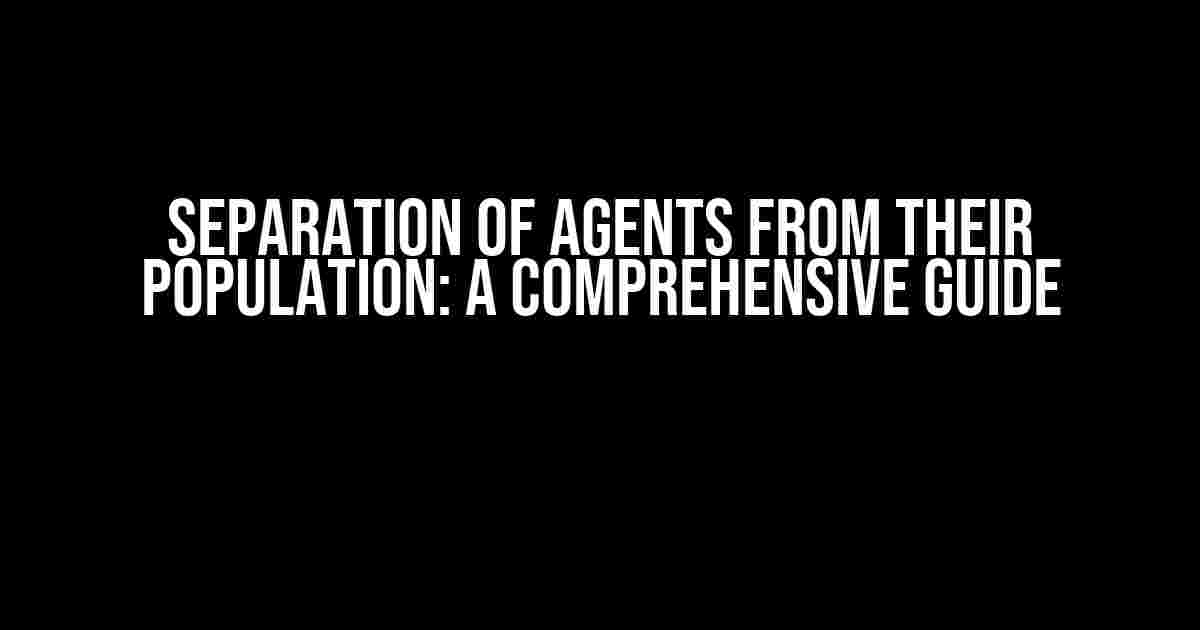Imagine a world where agents, be it artificial or human, live in harmony with their population. Sounds utopian, doesn’t it? However, the reality is far from it. Agents, especially in the realm of artificial intelligence, are often designed to operate independently, making it challenging to separate them from their population. In this article, we’ll delve into the world of separation of agents from their population, exploring the why, how, and what of this complex phenomenon.
Why Separate Agents from Their Population?
The primary reason for separating agents from their population is to ensure the well-being and safety of both the agents and the population. When agents are not separated, they can start to exhibit undesirable behaviors, such as:
- Overdependence: Agents may become too reliant on their population, leading to a lack of autonomy and decision-making capabilities.
- Contamination: Agents can contaminate their population with harmful or malicious behaviors, putting the entire ecosystem at risk.
- Inefficiency: Unseparated agents can lead to redundancy, inefficiency, and reduced overall performance.
The Benefits of Separation
Separating agents from their population can have numerous benefits, including:
- Improved Autonomy: Separated agents can develop their own decision-making capabilities, leading to increased autonomy and efficiency.
- Enhanced Security: Separation reduces the risk of contamination and ensures the security of both the agents and the population.
- Increased Efficiency: Separated agents can optimize their performance, leading to improved overall efficiency and productivity.
Methods for Separation of Agents
There are several methods for separating agents from their population, including:
1. Physical Separation
Physical separation involves separating agents from their population through physical barriers or distance. This method is commonly used in:
- Warehouses, where autonomous robots are separated from human workers.
- Data centers, where AI systems are isolated from each other and human operators.
2. Logical Separation
Logical separation involves separating agents from their population through software or algorithmic means. This method is commonly used in:
// Example of logical separation using Python
import random
def separate_agents(agents, population):
separated_agents = []
for agent in agents:
if random.randint(0, 1) == 1:
separated_agents.append(agent)
return separated_agents
agents = ['Agent1', 'Agent2', 'Agent3']
population = ['Human1', 'Human2', 'Human3']
separated_agents = separate_agents(agents, population)
print(separated_agents)
3. Hybrid Separation
Hybrid separation involves combining physical and logical separation methods. This approach is commonly used in:
| Method | Description |
|---|---|
| Physical | Separate agents from population using physical barriers or distance. |
| Logical | Separate agents from population using software or algorithmic means. |
| Hybrid | Combine physical and logical separation methods for enhanced security and efficiency. |
Challenges and Limitations
While separating agents from their population is crucial, there are several challenges and limitations to consider:
- Complexity: Separation methods can be complex and require significant resources and expertise.
- Scalability: Separation methods may not be scalable, making it challenging to apply them to large populations.
- Ethical Concerns: Separation methods can raise ethical concerns, such as bias and discrimination, if not implemented carefully.
Conclusion
In conclusion, separating agents from their population is a critical step in ensuring the well-being and safety of both the agents and the population. By understanding the why, how, and what of separation, we can develop more efficient, secure, and autonomous agents. Remember, separation is not a one-size-fits-all solution, and it’s essential to consider the unique challenges and limitations of each population.
As we move forward in the rapidly evolving world of artificial intelligence, it’s crucial to prioritize the separation of agents from their population. By doing so, we can create a harmonious coexistence between agents and their populations, paving the way for a brighter, more efficient future.
Frequently Asked Question
Unravel the mystery of separating agents from their population with these burning questions and expert answers!
What is the primary goal of separating agents from their population?
The primary goal of separating agents from their population is to identify and isolate individual agents or units that possess unique characteristics, traits, or properties that distinguish them from the rest of the population. This allows for targeted analysis, experimentation, or manipulation of the separated agents to gain a deeper understanding of their behavior, function, or potential applications.
What are some common methods used to separate agents from their population?
Some common methods used to separate agents from their population include filtration, centrifugation, sedimentation, chromatography, and fluorescence-activated cell sorting (FACS). The choice of method depends on the specific characteristics of the agents, such as size, shape, density, or surface properties, as well as the desired level of purity and precision.
What are the benefits of separating agents from their population?
Separating agents from their population can provide numerous benefits, including increased understanding of agent behavior, improved precision in experimentation, enhanced efficiency in production, and reduced contamination risks. It can also enable the discovery of new properties or applications of the separated agents, leading to breakthroughs in fields such as biotechnology, materials science, and pharmaceuticals.
What are some potential challenges or limitations of separating agents from their population?
Some potential challenges or limitations of separating agents from their population include the risk of contamination, sample degradation, or loss of agent viability during the separation process. Additionally, the complexity of the population, the presence of similar or identical agents, or the lack of clear distinguishing characteristics can make separation more difficult or unreliable.
What are some potential applications of separated agents in various fields?
Separated agents can have diverse applications across various fields, including biomedicine (e.g., targeted drug delivery, gene therapy), materials science (e.g., nanomaterials, catalysis), agriculture (e.g., precision farming, crop protection), and environmental monitoring (e.g., water quality, pollution detection). The specific application depends on the properties and characteristics of the separated agents.

